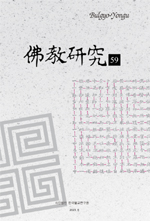- 영문명
- Interrobang: Hua-Tou and Copy
- 발행기관
- 한국불교연구원
- 저자명
- 송승훈(Seung Hoon Song)
- 간행물 정보
- 『불교연구』第63輯, 141~168쪽, 전체 28쪽
- 주제분류
- 인문학 > 불교학
- 파일형태
- 발행일자
- 2025.08.31
6,160원
구매일시로부터 72시간 이내에 다운로드 가능합니다.
이 학술논문 정보는 (주)교보문고와 각 발행기관 사이에 저작물 이용 계약이 체결된 것으로, 교보문고를 통해 제공되고 있습니다.

국문 초록
인테러뱅은 ‘‽’으로 표기되며 우리말로는 ‘물음느낌표’로 불린다. 이 부호에는 물음표(?)와 느낌표(!)가 공존한다. 이는 간화선 수행의 화두와 광고의 카피와 같은 구조로 설명할 수 있다. 화두는 “이 뭣고?”를 참구하여 그 질문을 타파해서 깨달음으로 안내하며, 카피는 광고를 보면서 “뭐지?”라는 호기심을 주지만 영상이 끝나면 궁금증이 풀린다. 이 둘의 공통점은 이야기의 제목이며 이야기 한가운데에 있다는 점이다. 또한 선어록의 각칙(各則)에 나타난 대화 시간은 방송 광고의 시간과 같은 6″, 15″, 30″, 60″(秒, second) 등이다. 찰스 샌더스 퍼스(Charles Sanders Peirce, 1839∼1914)는 기호를 설명하면서 기호, 대상, 해석소를 제시한다. 해석소는 전달자가 수용자에게 대상을 기호로 사용하면서 해석할 수 있게 하는 요소이다. 이는 화두와 카피에서도 적용된다. 선지식은 수행자에게 ‘활구(活句)’를 제시하여 깨달음에 이르게 해야 하며, 수행자가 화두의 본질을 통찰하지 못하고 문자에 집착할 경우 ‘사구(死句)’에 빠지게 된다. 이처럼 메시지의 본질을 제대로 전달하려는 노력은 광고 카피가 소비자에게 상품의 가치를 효과적으로 전달하려는 것과 같은 맥락이다. 퍼스가 제시한 기호의 3요소의 중요성은 르네 마그리트(René François Ghislain Magritte, 1898∼1967)의 작품인 “이것은 파이프가 아니다(Ceci n'est pas une pipe)”에서도 확인할 수 있다. 이미지는 실체가 아니라 실체를 전달하는 도구이다. 화두와 카피가 제시하는 문구를 제대로 이해할 때, 이들의 목적을 이룰 수 있으며 이것은 인테러뱅이 가진 기능을 잘 활용하는 것이다.
영문 초록
The interrobang, written as ‘‽,’ combines a question mark(?) and an exclamation mark(!). This structure is similar to that of a Hua-tou(話頭) in Ganhua-Zen(看話禪) practice and advertising copy. A Hua-tou guides a practitioner to enlightenment by posing a question like, “What is this?” Similarly, an advertising copy sparks curiosity with a question such as, “What is it?” which is then resolved by the ad’s message. Their commonality lies in the fact that they both serve as the title or opening of a story, appearing in the middle of a narrative to break the flow and prompt thought. To find the answer to a question, one must first accurately grasp its meaning. This principle aligns with Charles Sanders Peirce(1839∼1914)’s semiotic theory, which consists of three key components: a sign, an object, and an interpretant. The interpretant is the element that allows the recipient to understand the object through the sign provided by the sender. This concept applies to both a Hua-tou and an advertising copy. A Zen master must offer a practitioner a living word(活句) to guide them toward enlightenment. If a practitioner gets caught up in the words rather than the essence of a Hua-tou, they fall into a dead word(死句). A Zen master’s effort to properly convey the essence of a message is similar to how advertising copy aims to effectively communicate a product’s value to consumers. The importance of Peirce’s three elements of a sign is also evident in René Magritte(1898∼1967)’s work, Ceci n'est pas une pipe. The image itself is not reality but a tool to convey it. When you properly understand the phrases presented by a Hua-tou or an advertising copy, you can achieve their intended purpose. In doing so, you are effectively utilizing the core function of the interrobang.
목차
Ⅰ. 들어가며
Ⅱ. 인테러뱅의 구성
Ⅲ. 화두와 카피 구성
Ⅳ. 이미지의 배반과 수용
Ⅴ. 나가며
참고문헌
해당간행물 수록 논문
참고문헌
관련논문
인문학 > 불교학분야 BEST
더보기인문학 > 불교학분야 NEW
- 빠알리 주석서(Pāli-aṭṭhakathā)의 해석과 방법 - anassuṃ의 용례와 주석을 중심으로
- 曇延『大乘起信論義疏』現行テクストの成立過程について
- 진억(津億)의 수정결사 재고 - ‘역사-비교 방법론’에 기반하여
최근 이용한 논문
교보eBook 첫 방문을 환영 합니다!

신규가입 혜택 지급이 완료 되었습니다.
바로 사용 가능한 교보e캐시 1,000원 (유효기간 7일)
지금 바로 교보eBook의 다양한 콘텐츠를 이용해 보세요!



